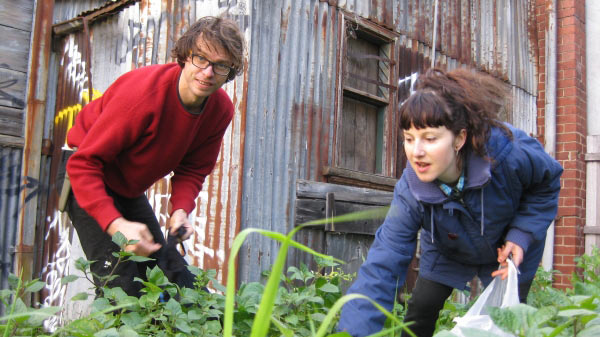The VEG Chook Files: Part One
CONVINCING YOUR FAMILY MEMBERS TO GET CHOOKS
Rest assured, it is a common scenario. You are totally sold on getting chooks, but your boyfriend or husband is adamant it won’t work – “the fox will get them!” Or, you are itching to release your inner poultry farmer, but your girlfriend or wife is concerned the neighbours will “complain about the inevitable smell.” Or perhaps you are a forward-thinking youngster trying to convince mum and dad that chooks are a great idea.
Whatever the reason, there is often a difference in how keen different family members are to get chooks. “I haven’t won my partner over yet, but one day…” is a line we hear a lot.
So, consider this article your ally in winning over family members and getting your family over the line that separates the poultry shy from the joyous poultried others. Let us consider their objections. Let us give each in turn our attention, and let us see each dissolve when examined from the perspective of a well-designed and managed chook system.
Let us also acknowledge that in some cases chooks or other poultry are not the right choice for your situation. Some objections, not many, but some objections, are actually really good reasons chooks aren’t for you. Sure. We’re obviously enthusiastic about getting chooks into suburban back yards, but as you’ll soon see, we’re also realistic about the situations in which they will and won’t work.
Here are the common objections we are aware of.
Objection One: What about foxes?
Objection Two: What about cats?
Objection Three: What about dogs?
Objection Three: What about smells?
Objection Four: What about rats?
Objection Five: What about noise?
Objection Six: What about going away?
Objection Seven: What about the extra work?
Objection Eight: What about the expense?
Objection Nine: What about the space?
Objection Ten: What about the regulations?
Objection Eleven: What about Diseases?
Objection One: What about foxes?
Foxes are rife in Melbourne and number many more per unit area than rural areas. It is wise to assume that where ever you are in Melbourne, save a 10th floor roof top garden with an electrified fence around it, chooks will be at risk from foxes during night hours. It is not unheard of for foxes to take chooks during daylight hours, but it is exceedingly rare, and only when there is a forested park, creek or similar close to your property. We know people that never lock up their chooks at night and who never have problems, but we know many more people who have left the door open for a single night and lost many of their chooks in one go (Foxes’ natural system is to kill more birds than they can eat in one go, and then to return each day for another corpse).
But, here’s the thing. A well designed, implemented and managed chook system is 100% fox proof. There are many design solutions out there. Let’s take ours as an example. We make sure the house and the adjoining strawyard (explained later) are fox proof. This takes a bit of effort to set up, but it’s worth it. The house itself is easy enough to fox proof, as is the roof and walls of the strawyard, which are all sturdy wire. It is the earth-floored strawyard that requires a little inside knowledge (note that the worst thing to have under chooks is concrete – see “What about Smell?”). Here’s the secret: continue the wire down into the ground 10cm, put a 90 degree bed, then continue it outward 40cm. Here’s a clip of this system being installed:
In this system, it is your job, when you are home, to let the chooks out of the strawyard in the morning, and to lock them back up at night. You never need to round up chooks at night. Once they know where home is, they will always come home to roost.
In addition to the house and strawyard we always have at least one and ideally two or more runs or exercise yards where the chooks can access more bugs and green plants, an important part of their diet. The runs are typically not fox proof, as the are more extensive and thus more expensive to cover, and you only let the chooks into the runs during the day or when you are around – times when foxes tend to keep their distance.
There are now automatic door openers and closers. We’ve not tried them, as they are expensive, and we think that if you are not motivated enough to visit the chooks twice a day, then you are probably best to reconsider rather than trying to automate your self out of the system.
Objection Two: What about cats?
This objection is a red herring. We have been designing and installing chook systems for over five years and we have spoken to many hundred of customers, friends and colleagues who have had chooks. Not one of them has ever had a problem with cats taking mature chooks.
Cats will spend hours and hours observing your chooks from the fence or roof, and it’s obvious what they are doing. They are fantasizing about taking the chooks, about unleashing the lion or tiger within. But there is a deep gulf between cat fantasy and cat reality. A domestic cat knows better than to take on something as big or larger than itself.
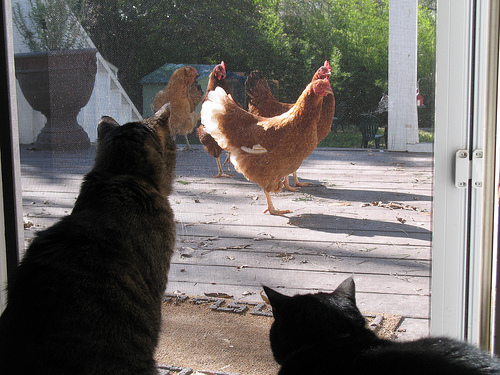
Baby chicks are a different story, as are the small wild birds that chooks tend to attract. They are little and indeed vulnerable to cats which of course regularly take birds of that size. But any self-respecting chook owner doesn’t let baby chicks loose outside, where the predatory birds and cold weather will make short work of those the cats don’t.
Bottom line, don’t worry about the cat factor, worry about something else, such as…
Objection Three: What about Dogs?
This objection is not a red herring. Many dogs will instinctively terrorise chooks, killing them in play if not intentionally. The first thing to figure out is whether your dog is chook friendly. Some dogs are. If not, or if you think they are just pretending to be disinterested whilst you’re watching (whilst licking their inner lips), then your chook system design needs to keep the dog and the chickens segregated.
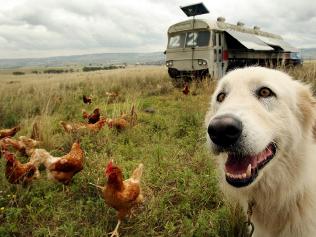
In practice, this rarely needs any further design or investment than a system without a dog in it, as all systems have areas the chooks are best kept out of – like the lawn, the vegie patch, & the back porch or patio. Luckily, these areas often turn out to be the same area you want the dog in, so it comes down to making sure the fence you use to keep the chooks in is sturdy enough to keep the dog out. In terms of packs of neighbourhood dogs coing for your chooks at night, as soon as the chooks are locked in their strawyard/house area then they are inaccessible by foxes (see “What about foxes?”) and hence inaccessible by dogs. Here is an example of a design where dogs and chooks (not to mention ducks!) must live together in the same backyard.

Eaglemont Design (more details here).
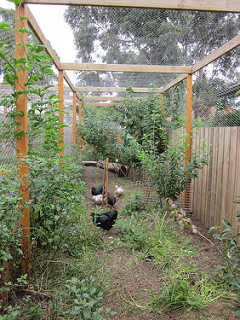
Photo of the fox & dog-proof chook/duck/fruit enclosure in the Eaglemont system sketched above.
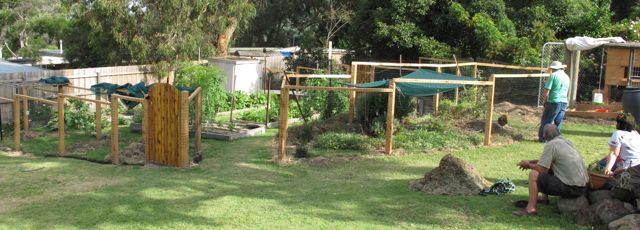
Another VEG Chook System with a run Fence that keeps chooks in and dogs out!
Objection Four: What about smells?
Chickens don’t smell bad. To the contrary, if you pick up a happy healthy chicken and hold it to your nose, it smells rather good! Seriously, try it; ruffle your nose through those soft feathers.
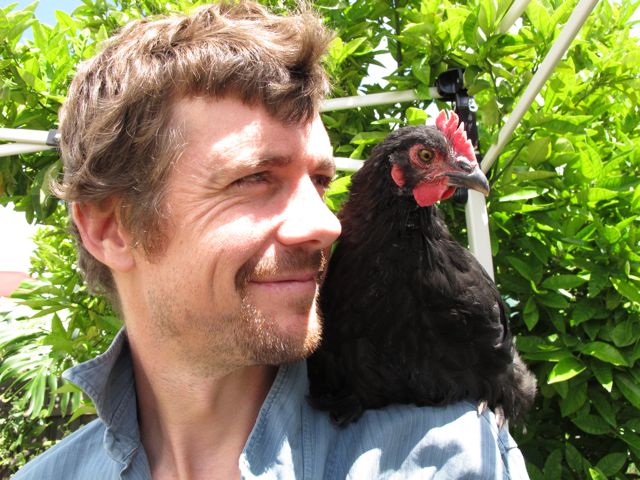
Seriously, you think Dan would have a chook this close to his nose if it smelled bad?
Sure, chook manure can smell, but only if it is poorly managed. Let’s make this point very clear: well-managed chook manure doesn’t smell bad. What smells bad is mismanaged chook manure. When you smell chook manure, what you smell is someone’s failure to manage that manure appropriately. What you smell is beneficial nutrients leave their system. Blowing away in the wind. Luckily, there is a simple and fail safe remedy to both the smell of manure and the leakage of nutrients. It’s called carbon. What are we talking about? We’re talking about wood chips. We’re talking about sawdust, about shredded newspaper, we’re talking about fallen oak leaves and we’re talking about straw. The common denominator here is carbon, the stuff all these things are made from, and generally something plentiful in any organic material that is dry and brown or tan in colour. Think of it as ‘carbrown’ if that helps.
How does carbon neutralise the smell of chook manure? Healthy aerobic decomposition is how. Along with sunlight, aerobic or oxygenated decomposition is one of nature’s sanitizers. The essential ingredients for this kind of decomposition are nitrogen, carbon, moisture and oxygen. Mix these things together and raw materials turn into black compost, rich soil and abundant growth. Chicken manure is very high in nitrogen or ‘nitrogreen’. For it to decompose in a healthy way, it needs to be combined with something high in carbon. Look at what happens when a bird defecates in a forest – the manure lands on a deep layer of fallen leaves, twigs and so on – in other words a layer of carbon. This carbon soaks up the nitrogen in the chook manure and renders it smell free. There is no doubt about this. It’s why forests don’t smell like bird poo and it’s why your backyard chook system can smell just lovely as it produces top-notch fertiliser for your garden.
What’s amazing is that not only do chooks add much-needed nitrogen to the composting process, in their incessant scratching they oxygenate the pile. If you look at a chickens feet what you see is two little pitchforks. All day long these little pitchforks are mixing the materials in your compost pile, pecking out unwanted bugs and seeds, and ensuring a rich flow of oxygen to the microbes busy at their work of healthy, aerobic decomposition.
The best system we’ve found for enabling your chooks to be the ultimate compost makers we call a strawyard. As mentioned in “What about foxes,” a strawyard is a small fully enclosed fox proof run adjoining the chook house.
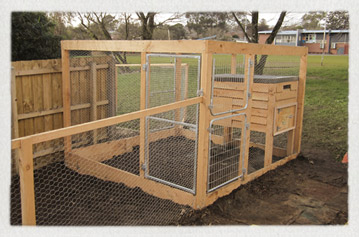
A Standard VEG Strawyard
Importantly the base of the strawyard must be earth covered in carbon. Concrete is the worst thing to have as the base in your chook house or strawyard, and bare earth is almost as bad. Here’s why. If chook manure accumulates on bare earth, concrete or wood, it not only stinks, it increases the chances of your chooks getting sick.

Objection Four: What about rats & mice?
Rats don’t care for chooks. Chooks never attract rats. What attracts rats is rat food. Whether or not rats have access to rat food is nothing to do with the chooks, and everything to do with how you manage the chook’s food. For chook food left out overnight becomes rat food.

This is how we like to explain it. Imagine each day you dump your kitchen scraps in the middle of your yard. You don’t have chooks. What happens as the stuff piles up? Yup, you got it, rodents are as sure a thing as smells & flies. Note that there are no chooks in this equation. It isn’t the chooks causing all these undesirables, it’s the food left to accumulate. This picture doesn’t change if you have chooks, where a mistake that is made is to put out more kitchen scraps and other forms of chook food than the chooks can either eat or scratch in before night falls. There are two implications: first, feed your chooks food scraps and the like as early in the day as possible, and second, don’t give them more than they can process before nightfall. In some cases your kitchen will produce more scraps than the chooks can keep up with, in which case you’ll need to find something else to do with the excess. A handy trick here is that if you have the time you can blend up your food scraps with bran or similar and feed the resultant mush to the chooks. This helps them eat 100% of it. In loose chunks generally some will get eaten and some left.
What about commercial chook mash, pellets or seed mix? You can keep this out of the path of rodents in at least two different ways. First, you can, as above only feed it out in the morning and feed out slightly less than they can eat in a day. This system has the benefit of encouraging the chooks to go forage for a component of their diet, which saves you money and makes them healthier. Second, you can make or buy a rodent proof-feeder as in the image below:
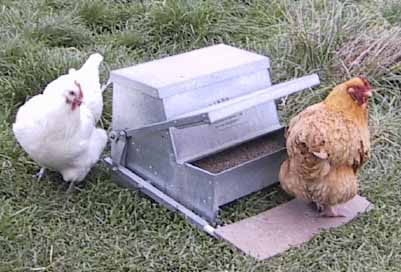
Objection Five: What about noise?
It is against regulations to keep roosters in most Melbourne suburbs – you can check out the council-by-council regulations for Melbourne here. As we all know, roosters (some more than others) make one heck of a racket. There are examples of roosters being housed in soundproof coops and only let out after the neighbours have gone to work, but most people will exclude roosters from their backyard flock.
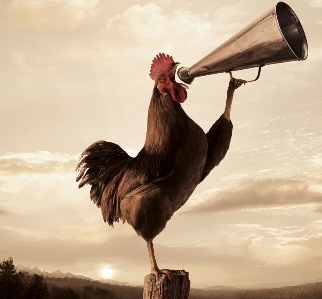
Most chickens make a few proud squawks having just laid an egg, as if to say “look at me – look what I just did!” They will also let you know if they are hungry, usually when you don’t show up at your normal feeding time.
Also some breeds are quieter than others. But by and large, noise is not going to be a problem. We have never heard of a neighbour complaining about noise, and personally we find a base level of background clucking very soothing, much like the sound of gently running water. Don’t forget humans have co-evolved with chooks for a very long time.
Objection Six: What about going away?
If you are away or more often than not or take regular two-week holidays then chooks are not for you. However for most situations this is a non-objection if you have a well-designed chook system. The beauty of the fox-proof strawyard system, in addition to letting the chooks make your compost for you (see “What about the smell?”), is that you can occasionally go away for up to about four days without compromising the health or happiness of your feathered friends. They can come and go between the house (where they sleep, lay eggs and take shelter from fierce weather) and the strawyard (where they can scratch, find bugs, eat scraps, get some sunlight and enjoy a dustbath). 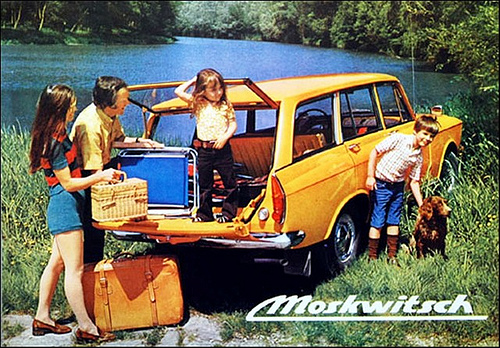 You’ll need a good sturdy waterer and feeder carrying a good weeks worth of both food and water, and then yes you can go away for two, three, even up to four days without your chooks overly suffering. They can eat, drink and come inside and out at their leisure. Ideally a friend or family member could visit them each day to feed them some greens and generally check in, but an occasional absence for a few days is not an issue. The problem is that after a few days you miss your chooks so much you get home sick and want to go home anyway.
You’ll need a good sturdy waterer and feeder carrying a good weeks worth of both food and water, and then yes you can go away for two, three, even up to four days without your chooks overly suffering. They can eat, drink and come inside and out at their leisure. Ideally a friend or family member could visit them each day to feed them some greens and generally check in, but an occasional absence for a few days is not an issue. The problem is that after a few days you miss your chooks so much you get home sick and want to go home anyway.
Objection Seven: What about the extra work?
Let’s get this straight – if you get it right chooks will massively decrease your workload. In other words, what extra work? You should be asking what you’ll be doing with the extra free time! The following common gardening jobs will be happily performed by chooks, not only saving you work and time but saving you money. Chooks can:
* Make your compost (see “What about the smell?”)
* De-weed your garden
* De-weed-seed your garden
* De-bug your garden
* Fertilise your veggies and fruit trees
* Entertain your kids and give them meaningful work
* Lay your eggs
Introducing chooks into a well-designed edible garden triggers a fertility explosion. Nutrients start cycling as chooks help rapidly decompose organic matter into forms soil microbes can then devour and feed back into plants.
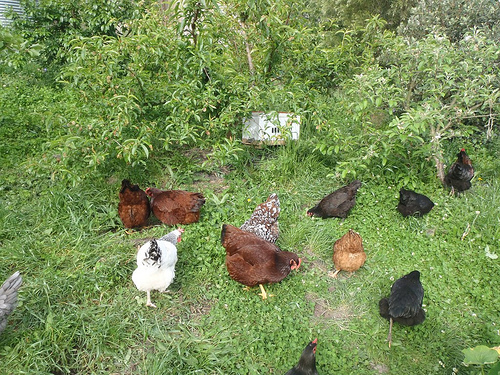
Happy, healthy & hard-working chooks in the VEG-designed Heathmont permaculture garden of VEG’s Education Manager Kim Glasgow just last weekend!
The reason becomes clear when we consider any natural ecosystem. Here, the animals play a vital part. Any forest, for example, has birds (amongst countless animals, insects & microbes) as an integral component. A backyard without chooks is often an incomplete ecosystem. You can feel this intuitively when chooks arrive. Suddenly your garden feels more complete.
In future articles in the VEG Chook Files we will look in more detail at systems you can use to let chooks happily reduce your workload. In the meantime, if you’re eager, check out The Small Scale Poultry Flock by Harvey Ussery – the best treatment of the subject we have seen.
Objection Eight: What about the expense?
Let’s do some math. A dozen organic free-range eggs will cost you about $7 in the shops. A 20-kilo bag of organic chook feed will cost you about $14. 20 kilos will translate into approximately 40 days food for four chooks, or about 120 eggs assuming you get three eggs per day from four chooks. In other words you might get $70 worth of eggs for $14 of food. Yup, that’s right, it stacks up! This excludes the cost of the chook house and so forth, but if you’re concerned about this, make it yourself for free from salvaged materials.

VEG’s education manager is an example of someone coming out well ahead. Kim sells her surplus eggs and the income totally covers her chook food, meaning her eggs cost her nothing, and nor does all the fertilising and pest control the chooks do.
Objection Nine: What about the space?
Chooks can get by with less space than you might think. That said, they do need a bit, and as a rule of thumb, we like to have at least 3 square metres of run per chook in addition to an adequately sized chook house & strawyard. One of the important things you lose when you have chooks in a very small space is the ability for the chooks to harvest their own greens. This isn’t the end of the world but happy healthy chooks do need daily access to greens, so if they can’t access them themselves, you’ll have to take them to them.
Objection Ten: What abut the regulations?
Check them out for Melbourne here or on the local government or council website for your area. Taking Melbourne as an example, you are allowed chooks in most if not all suburbs (see our listing of council-by-council regs here). So this is not a deal-breaker in most cases.
Objection Eleven: What about diseases?
Diseases are rarely a problem in (a) a well-managed flock in a well-designed chook system (b) sourced from reputable suppliers. A well-designed and managed system creates chooks so healthy they are very unlikely to get sick in the first place. Here are a few ways to ensure your chook are as healthy and resistant to disease as possible.
Manure
Any organism has an increased chance of getting sick if they eat their own poo or that of their fellows. This is one reason VEG chook houses have a poo-fall-through system where the manure generating by sleeping chooks falls straight through the floor into the straw yard where it is then scratched into the carbon layer such that by the time you deal with it it is rich, dark compost and a valuable resource for your garden. In many chook houses there is a solid floor that is kept bare. Manure accumulates here night after night and increases the chance that a chook might inadvertently eat some whilst scratching around. So keep this in mind – how are you going to deal with the poo?
Dry house
A moist chook house encourages moulds, fungis and so on which are another chook disease vector. Ventilate that house thoroughly!
Self-Harvest Medicinals
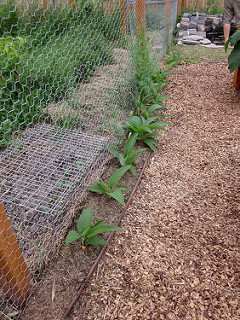
If chooks have daily access to certain following plants they will self medicate and maintain stronger immune systems. To your right you see a picture of comfrey planted on the outside of the chook run fence so chooks can help-themselves as it grows through the fence. Here’s a list of plants to consider:
- Comfrey – Wonderful herb for your organic garden. Perennial, large green leaves, grows in sun or partial shade, plant from a root cutting. Chop up and feed to chooks regularly. It is also a compost activator. Comfrey has a vigorous root system, so grow it away from your veggie patch.
- Nasturtium – Great for your chooks general health and it repels insect pests.
- Nettles – Helps increase egg production and is fattening for your chickens – a great winter food, but must be dried or they will not eat it. Nettle is also a compost activator.
- Rue – Good chook medicine & insect repellent. Dry and scatter through chook house to repel pests. Wear gloves when handling this herb as it can cause some skin irritation.
- Southernwood & Wormwood – Insect repellents and medicinal. Treats internal and external parasites. Grow wormwood away from other plants as its roots inhibit growth. Good to dry and scatter through chook house and laying boxes.
- Tansy – Attractive fern-like leaves with yellow flowers. Tansy is a vigorous grower that repels pest insects. Dry and scatter leaves through chookhouse. Tansy is also a compost activator.
- Rosemary – Insect repellent. Chop and scatter in chookhouse.

